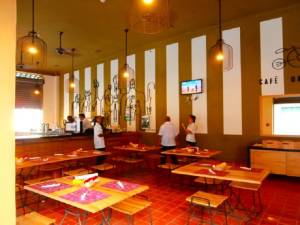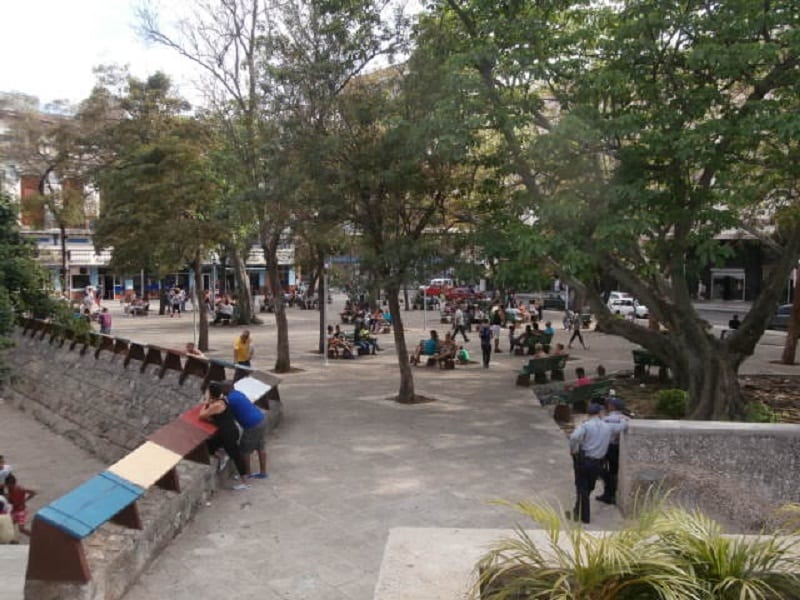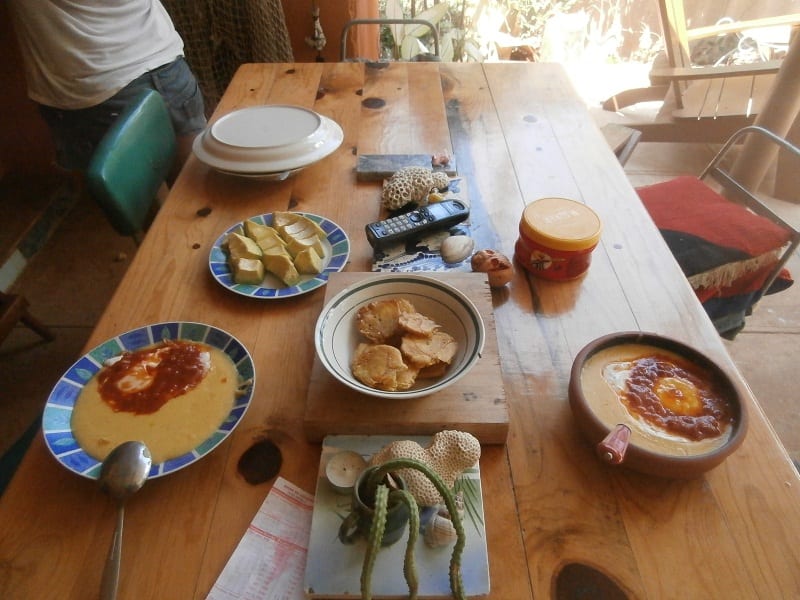Walking with My Nephew on Saturday in Old Havana
By Nike

HAVANA TIMES — On Saturday, I took my nephew out for a walk in Old Havana. We were thinking of seeing some museums but they were all closed. It was 1pm in the afternoon. The only place we could go to was the Mambi Presidential train museum and we had a really friendly girl as guide.
Afterwards, looking for somewhere to eat, we arrived at the Havana Cafe found on the corner of Mercaderes and Amargura Streets. It was opened in the ‘90s for ordinary Cubans, so we would have somewhere to go and eat and have a good cup of coffee paying in Cuban pesos.
All kinds of people used to go there: it was a meeting point for those who used to go the classical music concerts at the San Francisco de Assis Basilica, it was also where workers in Old Havana used to go and have coffee after lunch and neighbors of the Cafe were regular customers. Cubans are coffee-lovers by tradition.
It had recently been closed for maintenance works. This was my first visit back since it had reopened. It’d been fixed up real nice with iron and wooden seats which fitted in well with the bar and tables. I really liked the light fixtures too, congratulations to the designer. But what a surprise! Nobody was eating or drinking coffee there. I was insulted when I took a look at the menu. Everything was priced in CUC (the equivalent of USD).

To give you some kind of idea of what I’m talking about, here are some of the prices that I still remember: a fried egg with chips used to cost 8 regular Cuban pesos, soup was 3.50 pesos and coffee, like I told you it was really good, used to cost 90 cents of a Cuban peso for a cup.
Now, just to tell you how much the coffee’s gone up, a cup now costs 75 cents of CUC, which translated into Cuban pesos is 18 pesos. My nephew and I were deeply saddened.
These are the kinds of things that I don’t like happening in our country. Don’t we Cubans have the right to sit down at a table in a pleasant space and eat or have a good cup of coffee at a reasonable price that fits with what we earn?
We ended up sitting in one of Havana’s parks and eating pizzas from a privately-owned cafe.
The next day, because my nephew still wanted to eat fried eggs, I went to the agromarket in my town and as they had native corn flour, I bought two pounds worth and I was especially lucky that day because I walked past a house that was selling breadfruit. This is a strange fruit, Cuban farmers always have a breadfruit tree in their homes and when they move or are going to buy a house, if it doesn’t have a breadfruit tree, they don’t want it. This is because this tree feeds both the family and animals in that household. Here are some photos of the delicious lunch I cooked for my nephew. I was very happy.

Let me tell you how I prepared the breadfruit. I fried it this time, but you can boil it too.
You peel it and then chop it into small squares. You then fry it for a short while, you take it out and mash it as if it were a banana and then you fry it again in hot oil.
You have to cook the flour on low heat always stirring it for about 15 to 20 minutes. At the end, you add a tiny bit of salt.
When all of this is ready, you fry the eggs with a small amount of tomato puree. Our Sunday lunch, do you want some?
Click on the thumbnails below to view all the photos in this gallery. On your PC or laptop, you can use the directional arrows on the keyboard to move within the gallery. On cell phones use the keys on the screen.















I would argue that it is not free markets which endanger democracy in the West, but a growing authoritarian alliance between political parties, corporations and big unions which are moving our countries toward oligarchic monopolies. The West could benefit from a return to freer markets and away from the over-regulated societies that have developed over the past 50 years.
Oh, that free market economy, which has led to most of the world living the lie that it can afford to keep topping up the fortunes of the super-rich while sitting on trillions of dollars of debt that can never be repaid.
If you equate poverty with a lack of TVs and computers, Cuba’s poor. If you measure it by the hopeless and homeless on the streets, the ‘developed economies’ beat Cuba by a country mile.
I wouldn’t argue that there must be change in Cuba, but heaven help them if they engage in the same free market economics which are busy destroying democracy. We think we vote for the people we want, but all we have to choose from are politicians who only promote policies which make their friends richer, while waiting for their chance themselves to hop aboard and live like kings.
It was shorthand for the division of products into those for locals and those for visitors; I know of nowhere else this happens.
The concept that “Cuba is doing better everyday” is a myth. My home is in Cuba and there has been no improvement in the daily lives of Cubans at all. Cubans need all the good luck they can get but nothing will improve under communist rule the declared purpose of which – as declared by ‘Che’ Guevara is to:
“learn to think as a mass. to think as an individual is criminal.”
There is already a policy of price controls in Cuba and it has lead, as always, to shortages, pilfering and corruption.
What Cuba needs is a free market economy, with one currency, free and independent labour unions, the right of all citizens to own private property, and a modern & transparent banking system.
Thank you for basically confirming everything I posted, I was trying to make my reply simple and straightforward so Mark could understand the situation.
Your further details will hopefully help in convincing him that apartheid is not a meaningful or accurate term in this situation.
Far better jim for the Castro regime to align wages with prices. Cubans have to exist on a pittance and that is the root of the problem described by Nike.
Actually Eden the official conversion rate is 1 CUC = 25 CUP. There is a 1 CUP charge for conversion. Saying that the single currency will appear in the near future is optimistic as it is now three years since the regime announced that it was going to revert to a single currency, but that has yet to occur and I believe it is due to concerns about an inflationary effect.
Regarding prices, you are correct in saying that electricity is subsidized, but remember also that whereas the first 50 units are at a charge of 0.09 CUP, the price rises to 2 CUP at 500 units and to 3 CUP at 1,000 units and so on upward.
Until 2015, bottled gas was only available to those lucky enough (Party members) to have a ration, at 7 CUP per bottle with a limitation of 2 bottles per year. The price for others on the mercado negra was 200 CUP. In 2015 gas became legally available to all at a price of 110 CUP when available, but those with a ration continue to receive those two cylinders a year for 7 CUP. The reason for making gas available to all was that the various GAESA subsidiary shops were selling gas stoves at a very high mark-up.
Telephone through ETECSA or Cubacel or Nauta is cheap for internal calls by western world standards, but international calls are exorbitant.
Transport by converted old trucks (taxi particulars) is cheap (1,20 CUC for 60 km) although passengers sit on metal benches or stand packed together, but those cheaper prices do not apply to Astro bus services and certainly not to Viazul (25 CUC single Havana/Trinidad).
School education is free in most western countries. Yes, when my wife and i visit museums, art galleries etc. she as a Cuban usually has to pay about 5% of the charges I pay.
The “apartheid” is possibly a reference to the monthly ‘earnings’ being paid in cash using CUP. Until this year the GAESA owned shops and businesses charged only in CUC as the regime needs hard currency and that was why Fidel Castro introduced the CUC originally.
Although it is possible that there will eventually be a reversion to a single currency, Cuba will still not have a currency acceptable on world markets.
I hope that this is a helpful addendum.
You’ve never experienced higher prices in tourist zones anywhere in the world? Really?!
What do you mean with the term, “currency apartheid?” 1 CUC = 24 CUP. If a beer costs 1 CUC then you can also pay 24 CUP, it’s the very same amount of money. If something costs 12 CUP then you can pay .50 CUC, it’s the very same amount of money. Anyone – local or foreigner – can freely use CUC and CUP. Where does “apartheid” enter the equation?
Some services and purchases are hugely subsidized by the government so they’re available in CUP at greatly reduced prices to Cuban locals. Transport, electricity, gas, telephone, education, admissions, etc. cost pennies compared to prices in the western world.
Lastly, Cuba has already announced merging the two currencies sometime in the near future the CUC will cease to exist and CUP will be the standard currency.
The photos makes me hungry! I hope someday that Cuba gets prices aligned with wages … properly. Jim
Having never experienced this I cannot fully appreciate or understand fully what is taking place in Cuba at present, all I do know is that the Cuban people deserve better.
“… These are the kinds of things that I don’t like happening in our
country. Don’t we Cubans have the right to sit down at a table in a
pleasant space and eat or have a good cup of coffee at a reasonable
price that fits with what we earn?…”
=====================
That’s a really naive statement and the short answer is no, you don’t. Not
at Ground Zero in the most expensive tourist zone on the entire island.
This is the same almost anywhere in the world, most locals would never dream of paying the highest tourist prices possible when “local prices” exist just a few blocks away. I know a half dozen places within a 5 minute walk that would have served you a fried egg and coffee for super cheap.
Welcome to the real world, amigo.
That’s one part of the Cuban economy that stumped me; the currency ‘apartheid.’ As a visitor, I found the opposite at Parque Coppelia when I tried to buy an ice cream; only local pesos, I was told. It’s time the Cuban government stabilised this situation, either finding more money for workers or controlling prices. Either way, at some point, Cuba needs a single currency.
I’m glad that Cuba is doing better everyday (as far as I can see from far away, from Europe).. but.. Croatia had a similar way.. there will be less and less places for cubans to go eat and drink.. You will have ‘more options’ but for much more money.. I wish you good luck!